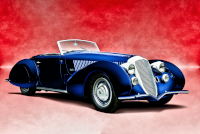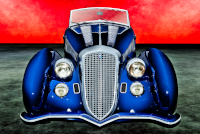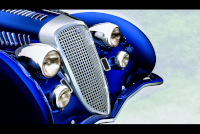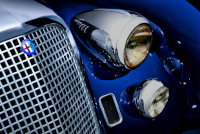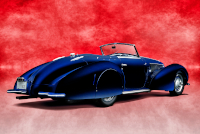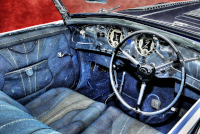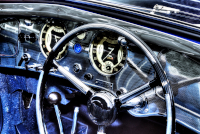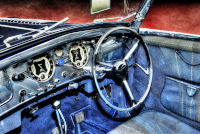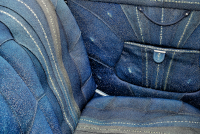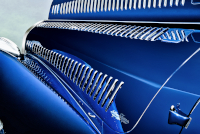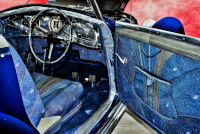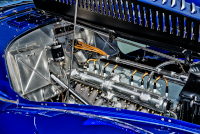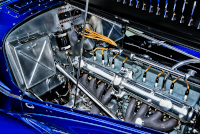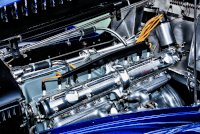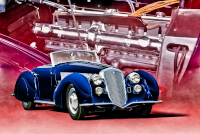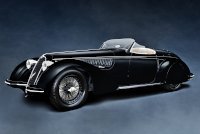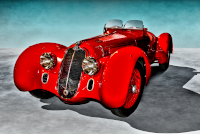Location:
Amelia Island Concours d'Elegance, 2025
Owner: Arturo Keller (late), Pyramids Collection | Petaluma, California
Prologue:
In terms of automobiles I would like to photograph and profile, my Alfa Romeo wish list is longer than that of any other marque. This 8C 2900B is one such wish list item, commonly referred to as Giuseppe Farina's 8C.
The Farina family connection is foundational, yet also fleeting. In my way of regarding oft-repeated monikers with suspicion—how we so frequently neglect the broader context—I surmise that Battista and Giovanni crafted a car based on their admiration of young Nino just as much as the car was ever intended for him. His ownership lasts for the shortest period of any individual in the car's history, which leads me to wonder about the genesis of the project, as well as the circumstances that led to Nino Farina's prompt disposition of the car.
What we see today is a combination of Stabilimenti Farina's luxury excess properly reconditioned under the stewardship of Arturo Keller, whose family's care has lasted over 30 years. While the car is extraordinary, it is also difficult to understand. Even with the assistance of Simon Moore's account, I find myself troubled to answer all questions about the intrinsic nature of the beast. I am perhaps too critical, particularly where the eye candy should well enough justify the effort. But then recent media outlets touting the car's best of show award do not begin from a position of authority, and ultimately fall far from the truth.
As Moore, notes, "In the first edition, I speculated that this car might have been the prototype for the 1938 Mille Miglia cars but that is not the case." So chassis #412028 was originally a road car that received cabriolet coachwork by Battista "Pinin" Farina, not a rebodied race car. Just another instance to note that, as writers, we often reach for that extra anecdote to make an automobile seem more special. All too often, the words are hollow. And in this case, they needn't be. The car is fine enough on its own.
Lastly, I will give a quick nod to Joe from Hyman Ltd., who commented that he was interested to see what I might do with this piece. I hope the results meet expectations.
- - - - - - - - - -
► Image Source: Nikon D750 (24.3 MP) | Image 6 finished at 28.3 MP
References:
- Automobile Quarterly, Volume 11, Number 2, Second Quarter 1973, "The Immortal Alfa Romeo Two-Nine" by Peter Hull and Simon Moore, The Kutztown Publishing Company, Inc., Kutztown, PA, page 181
- Moore, Simon. "The Immortal 2.9: Alfa Romeo 8C2900, Revised Edition" Parkside Publications, Inc., Seattle, WA. 2008, pages 254-260, 444, 446-453, 456-457, 461, and others
A Thematic Gesture: The Giuseppe Farina 8C 2900B
If there remains any story yet unexplained about chassis #412028, it is why Farina keeps the car for such a short period of time. His ownership lasts less than three full months, from January 31, 1939 to April 20, 1939. And yet we (who so often cite famous names without understanding the full context) like to think of this car as Farina's.
The speculative answer involves family ties (of course), as Nino Farina is the son of Stabilimenti Farina founder Giovanni Farina, and nephew of designer Battista "Pinin" Farina. At the very least, gifting the car to Nino keeps the registration active till its purchase by Alesandro Riretti of Biella; it is not initially Nino's, but registered to the Alfa Romeo factory in Milano. Simon Moore does not broach this topic directly. But the dashboard bears a small engraved plate that reads, "Giuseppe Farina M M 1938," which sits just to the left of the steering column. Visible in period photos, it seems likely that this commemorative token is original.
Chances are, the coachbuilder trades on its scion's name for the sake of the project. Even before Nino Farina receives the car in early 1939, chassis #412028 appears in the November 1938 edition of "Alfa Corse," where Moore notes the magazine grandiosely label the car as the, "Mille Miglia of Italian champion, Giuseppe Farina," though it is not an MM-spec 8C. In this case, the racing driver's involvement could be part of the car's marketing plan, a Nino Farina-themed 8C owned by the man himself. Pardon me the speculation. I am simply thinking through the process to connect the car's mystique to its known history.
In this regard, Moore does a spot of speculation himself. He cites two photographs uncovered in the Porsche archives by Egon Zweimuller from the 1938 German Grand Prix at the Nürburgring. The car rides on its original Milano plates, registered to Alfa Romeo, which leads Moore to suggest that maybe one of the works drivers took the car to the race, and if so, that driver was probably Nino Farina. If this bit of speculation is true, then Nino's personal connection to the car is slightly greater than two months and three weeks, in which case his brief ownership is a mere formality. But whether Stabilimenti Farina design the car for Nino, as opposed to designing the car to be about Nino, is not immediately clear.
That might sound like a meaningless question, but the difference is whether Nino Farina's father and uncle design the car to his liking with every intention that it should be for him, as opposed to whether they trade on his popularity to create a showpiece that demonstrates their luxury coachbuilding prowess. And if the answer to this question is the former, that the car would be for Nino exclusively, then that naturally breeds the question of what circumstances precipitate the car's sale.
War is not the answer, as Farina continues racing for a further two years. And as it passes from owner to owner, chassis #412028 remains known to Italian motor registration records through January of 1943. More likely, Farina would simply want to fund his racing career, and that being the case, he would never have planned to keep the car. Speculation, for sure. But in this respect, I view the Giuseppe Farina moniker as a thematic device rather than a personal investment.
Chassis #412028 History and Itinerary
As I am not a proponent of listing owner histories for no reason, I will report that no fewer than five individuals take ownership of #412028 in Italy through World War II, before the car ventures to the United States via Luigi Chinetti to the oft-referenced Tommy Lee. Lee is the first of no fewer than six post-War American owners.
Chassis #412028 appears on the cover of the October 1951 issue of Road & Track, then owned by Peter Sartori. By this point, partial rear wheel inserts replace the full rear wheel skirts. The car later appears at Pebble Beach in 1956, known from photographs but without clarity on the owner at the time. At this point, the Alfa wears a predictable coat of red paint. The wire wheels are black and have lost their center caps. The original thin guards with their intricate curvatures have been replaced by larger straight units. The partial rear wheel inserts remain.
By 1964, chassis #412028 appears on display in Bill Harrah's museum in Reno, Nevada. One can find color photographs of the car in this configuration, likely from a 1965 Automobile Quarterly. The Alfa stays in Harrah's collection until 1983.
Skipping one owner subsequent to the Harrah auction, the car next spends time in Berne, Switzerland through the late 1980s and early 1990s. Simon Moore visits owner Al Guggisberg, who has purchased the car sight unseen, and finds #412028 in unrestored condition, though "looking rather sad in the old Graber coachworks building with the radiator and grille removed, as well as the engine which was out being rebuilt by mechanic Ernst Anner." This period marks the beginning of the Alfa's rejuvenation.
Sometime prior to 1994, the 8C moves back to the United States, now in better condition, though back on the continent a photo appears in a coachbuilders article by Michele Marchiano in the September 1995 issue of "La Manovella," which is still today the official magazine of the Automotoclub Storico Italiano (ASI).
The new American owner is the late Arturo Keller, whose stewardship continues today through his family, lasting over 30 years. The man entrusted with the restoration is Mike Fennell of Los Angeles, who contacts Simon Moore for guidance on the details Moore collected when he saw the car in Switzerland. Restoration concludes by December of 1994.
Now returned to its original configuration (less a few details Moore notes disappeared after the car returned to the US from Switzerland), Arturo Keller shows the Alfa Romeo at Villa d'Este in 1995, Amelia Island in 2005, and the Quail in 2007.
These notes comprise most of the instances in which we might see images of #412028 based on publications and public appearances. Another period photograph indicates the car may have been painted a very light color, possibly white, though I do not know when and where that would be.
In any case, the 8C's return to Amelia Island in 2025 connects a 21-year period between appearances at that event, and the car's condition remains rather pleasing. Media outlets tout the car's best of show award, though it stands to note that the current restoration is aged. The top, for instance, requires some repair, though it is functional and visually respectable. And the motor bay has endured some paint chips along the edges typical of regular use. However, the paint is rather good overall, perhaps refreshed more recently because it does not look like a 30-year-old coat. And the cockpit is simply too extravagantly complicated for imperfections to stand out.
Having weighed the car's condition, (and listened to its distinctively smooth purrr under power), I would surmise that the Amelia folks appreciate the spectacle for what it is, and may have vaunted the car on emotional grounds as much as objective critique. I'm not one to question. To me, the matter of concours awards is separate from real historical significance, perhaps even irrelevant. Yes, it is fun to pick and chose favorites. But I would rather let history bolster my sense of awe.
In this case, history is on the side of design. Any chance to see a truly unique, A-list classic is a privilege. This 8C 2900 offers so many delicacies that it has become a stand-out example among all classic cars. And that seems to be Stabilimenti Farina's objective, to design a cherished object of the "wow" variety, whatever Nino's personal interest might have been.
Motor: 2,905 cc straight 8-cylinder, alloy block, fixed aluminum hemi-head | 68 mm x 100 mm | 5.75:1 compression
Chassis #412028 retains a matching-number motor, #412028.
Moore notes that the first engineering drawings for the 2.9 motor date from October 1934, and that this motor is ostensibly different than the Tipo 308. The roadgoing 8C 2900 motor uses combustion chambers domed at 13 mm with valves set at 104 degrees, and is a fully gear-driven unit.
The crankcase uses ten main bearings, and given the central chain-drive configuration, splits in two pieces joined together at the middle. Moore notes that, "the rear main bearing was redesigned to better cope with the stresses inherent in the 2.9 driveline; this involved a slightly longer bearing and a four-bolt fixing rather than two."
As we look at the motor in situ, we see these notable attachments: The pump canister attached to the firewall is a Freni Farina brake fluid reservoir. The magneto is a Scintilla Vertex unit driven off the back of the intake camshaft. There are two obvious alloy boxes attached to the firewall, each with X-braced stamped covers. The box on the exhaust side is a tool box. The box on the intake side houses the battery.
Valvetrain: DOHC, 2 valves per cylinder, gear-driven via a central mechanism between each 4-cylinder block
Aspiration: twin Weber BS42 carburetors with twin Roots-type superchargers, each of which feeds one 4-cylinder block
Moore notes that the side-draft carburetors are handed, that is, fixed in mirrored positions. The superchargers are of a smaller type than used on the Tipo 308 motor.
Power: 180 bhp at 5,200 rpm
Compared to the race-bred 2900A, the road-going B uses a tame 5.75:1 compression ratio, down from the sports-racer's 6.5:1.
Drivetrain: 4-speed gearbox in transaxle rear-wheel drive layout
Front Suspension: independent dual trailing arms (A arms), enclosed coil springs over dampers
In the last image of this gallery, we can see the bolts that connect at the base of the cylindrical spring and damper units, which connect to the chassis at the top. Those lower lateral arms are drilled. The two main trailing arms are simple A-shaped pieces that surround the canister. Moore dates the original design to May 1, 1935, and notes that, "the same type of unit, originally designed by Porsche, was used in all the 6C 2500 series until the early 1950s." The suspension configuration is one of two contracts given to Porsche by Alfa Romeo from 1934.
Rear Suspension: independent swing axle on transverse semi-elliptic leaf springs with radius arms for location and both hydraulic and friction dampers
The rear suspension is semi-independent and mechanically adjustable, which allows the driver to tune handling characteristics and, as Moore notes, "prevent the worst swing axle effects." But this configuration can also upset the handling if not properly dialed in. Referencing Mike Sparken's description, there are two bolts with counter nuts that act as semi-stops for the transverse rear leaf spring. "The transverse leaf spring is on a pivot at the centre which is quite amusing when you think about it because without those two bolts acting as stops you would have a chassis—a whole car—which could just pivot on that spring without being held, so in a corner would just lean over without actually pushing down on the spring."
Period Alfa Romeo lead test driver, Giambattista Guidotti, recommends that the bolts be set at 2 mm for touring and zero for racing. As Sparken writes, if the bolts are not set evenly, then the rear end pushes the car at different rates simultaneously under cornering force. He chose a setting of ½ mm to 1 mm for a firm characteristic, as best as can be managed while the car sits completely level, considering the bolts can't be seen but only felt.
Architecture: steel ladder-frame chassis with coachwork by Stabilimenti Farina of Torino
Kerb Weight: approximately 1,400 kg (3,086.4 lbs)
The lungo Touring Spider weighs 1,377 kg (3,036 lbs), so the estimate above adds some margin for what I presume is slightly heavier coachwork.
Wheelbase: 3,000 mm (118.1 inches)
0-60: about 10 seconds
Top Speed: 170 km/h (about 105.6 mph)
Alfa Romeo provided an estimate of 106 mph for the Touring Spider at the time of 1937 motoring journalist reviews. That said, hedging a round figure of 170 km/h could even be ambitious if we presume that the Stabilimenti Farina coachwork is slightly heavier than Touring's Superleggera method.
Etymology:
'8C 2900' refers to the motor, an 8-cylinder of 2.9 litre displacement. The 'B' designation refers to the second version of the 2900 development program, which begins in 1935 with the 2900A. 'Lungo' indicates this example is one of the long wheelbase versions, or passo lungo. As described below, #412028 is not a spider, but a cabriolet.
Figures:
Simon Moore lists 51 8C 2900 chassis plus one additional motor. On these chassis, Touring provide the most recognizable styles—the short chassis spider (corto), the long chassis spider (lungo), and the long chassis berlinetta—totaling 18 original examples of the 2900B.
A few anomalies append that list, including #412012, an early racing spider that was lengthened and rebodied as a cabriolet by Pinin Farina either in late 1938 or 1939. Another anomaly is this long chassis cabriolet bodied by Stabilimenti Farina. Moore explains that the difference between the spider and cabriolet is chiefly that the cabriolet uses full windows that roll up to the hood, completely enclosing the cabin. The spiders use cut-down windows and a rudimentary hood pinned to the frame and body, whereas the cabriolet top is a bit more substantial (though not by much).
In any case, #412028 is a unique design exercise. The car has undergone a number of color changes in its life, but today appears in the same general form as first registered in Milano. I do believe, however, that the current hood is black, whereas the original appears to have been a light tan.
Sapphire Car: Stabilimenti Farina Luxury Compared to the 8C 2900 Touring Spider
The Stabilimenti Farina exercise departs primarily from the Touring design by omitting the Alfa Romeo grille. Farina craft an egg crate grille with a deft vee shape, then fold the Alfa Romeo badge along the center line to accommodate. The shroud is deep and fully plated, bright contrast to the body-matched shrouds of the Touring cars with their kidney-shaped vents. Extra driving lights and low rectangular vents fill the valance, whereas the overall shape throughout the fascia is very similar to the Touring cars.
Note that the grille does not include an outlet for a starter crank. Moore notes that the 8C 2900 originally used Bosch, Magneti Marelli, and Scintilla starter motors, and I can confirm that this car uses a Marelli unit.
The front guards are remarkable; they gently hook around the front skirts while the middle dips in a slight vee to echo the lower edge of the grille, an elegant configuration specific to this car.
Most remarkable are the four sets of louvres on the bonnet, every louvre edged by chrome plates, every chrome plate bolted on. Now, an interesting feature of the 8C 2900B is that the bonnet sides are not double-hinged; they are each single wings, which allows free access to both sides of the motor (without the need to fold one bonnet side over the other). On chassis #412028, the bonnet appears to be deeper than on the Touring cars. Along with an excess of chromed louvres, this arrangement makes the bonnet wings bigger and probably a bit heavier. Perhaps as a result, Farina position the braces in the middle of the bay, whereas Touring mount the braces in a less obtrusive position toward the front. (This difference jumps out when trying to properly focus a lens on the motor when alongside the car.)
Farina also add their signature in chrome, "Stabilimenti Farina, Gran Lusso Torino," at the lower edge of the bonnet sides. The placement adds yet more busyness to the bonnet, but keeps the flanks clear and tidy. Another intriguing design decision that promotes cleanliness along the flank, Farina fit trafficators within the rear skirts. On the lungo spider, Touring mount trafficators just aft of the door. But the Farina shape feels more tightly integrated, as if the design brief aims for contour, not so speedy as the chrome strakes along the flanks of the Touring Spider.
Neither would trafficators fit on the bulkhead. Farina add vent hatches for the footwell compartment and use a large external door hinge, whereas Touring's hinge fits flush to the body. More appropriate for a cabriolet with full windows, #412028 also uses a proper door handle and a lock, both of which would be superfluous on a spider.
Another principle design departure is the tail. Farina shape a broad tapertail deck with soffits between the skirts that mimic those at the front. A modest dorsal fin traipses down the center line, a complex bit of panelcraft with strong aerodynamic influence. The rear guards match the front, but in abbreviated fashion, leaving the terminal point of the tail fin unprotected.
Farina's wheel treatment, with color-matched spokes and wheel caps, completes a style indicative of the coachbuilder's broader ethic. Stabilimenti Farina design pretty cars, and will continue to do so in the post-War era. In this respect, chassis #412028 fits the design language seen on later Alfa Romeo, Cisitalia, and Fiat automobiles.
Stingray Seats: The Alfa Romeo's Odd Shagreen
A word on the minor ecological disaster that is the interior of #412028. Shagreen is the tough hide of the stingray, or in some cases shark. The material's chief characteristic is texture and durability. Particularly with the intricate stingray markings retained, the material is rough; it looks extravagant, but would not feel as luxurious as conventional cow hides.
The Stabilimenti Farina 8C uses shagreen on the seats, doors, footwells, lower dashboard structure, and rear compartment, as well as for a set of small travel bags. While recognizable as animal hide on soft surfaces, the shagreen fixed like Christmas wrap to the hard surfaces below the dashboard achieves a strange, almost metallic look, as if part of a moulded structure. At a glance, the material might seem different if not for the seams that show how it is pieced together in a similar fashion as the seats.
Over the years, the stingray interior has become a famous feature of chassis #412028, though I cannot confirm whether it is original. In some sense, I appreciate the extravagance. I appreciate seeing a wonder I probably won't see anywhere else. From a practical standpoint, however, the interior is a cobalt explosion finished to such excess that it becomes difficult to view the product as anything purely automotive.
Also, from a design standpoint, something feels off. When I first saw the car in person, I couldn't clearly articulate what the issue is, but on reflection I think the answer is dissonance. The blue-on-blue livery is disharmonious because the interior is a hard cobalt whereas the exterior is sapphire. The dominant hues do not quite match, where the interior trends toward a green hue, particularly in its mix of blue-greys, while the exterior hue is deeper and warmer. This effect is not wholly dependent on sunlight, though a natural environment exacerbates the difference by extracting a hint of purple from the paint. When balancing the color in these illustrations, the difference is obvious.
So we do not see a harmonious blend of common hues, inside and out, and neither do we see a complementary contrast color. This is not a call for change, merely an observation.
Final Touches: Chassis #412028 Cockpit Details
An immense supply of shagreen distracts from a few remarkable details, namely the intricately engraved dashboard panel. The layout is similar, but not identical to a Touring Spider, with added switch gear particular to this car. A Saint Christopher emblem sits between two standard Veglia gauges, the badge tinted blue in keeping with the theme. The dash itself would seem blue as well for its reflective quality, whereas the polished aluminum surface matches the thick chrome binding around the cockpit.
The dashboard uses a horizontal filigree band pattern, although there are two sections either side of the main gauge of five open polished stripes separated by four fine double bands. This subtle change of pattern gives the main gauge an unexpected sunburst setting, and trips the eye just enough not to be overwhelmed by the filigree.
The steering wheel adds chrome inserts on the rim and spokes, an embellishment beyond the standard black wheel. The windscreen frame, more substantial than that of the spider, pivots outward from the top. And for those unfamiliar with the classic Alfa Romeo pedal arrangement, #412028 uses familiar rubber pedals with the steel central throttle nub. The brake remains on the right, and the clutch on the left.
Last Updated: May 4, 2025

